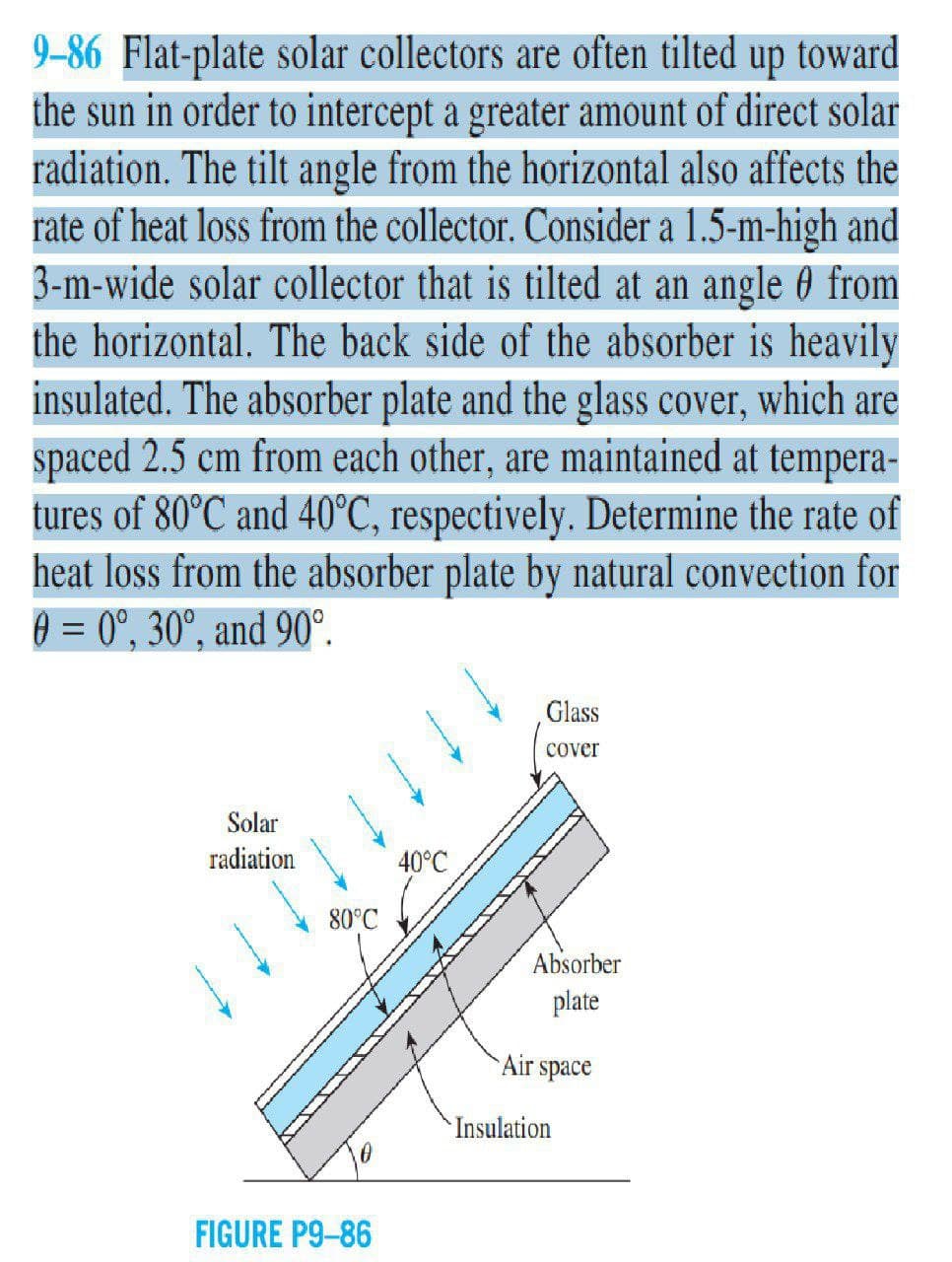9-86 Flat-plate solar collectors are often tilted up toward the sun in order to intercept a greater amount of direct solar radiation. The tilt angle from the horizontal also affects the rate of heat loss from the collector. Consider a 1.5-m-high and 3-m-wide solar collector that is tilted at an angle 0 from the horizontal. The back side of the absorber is heavily insulated. The absorber plate and the glass cover, which are spaced 2.5 cm from each other, are maintained at tempera- tures of 80°C and 40°C, respectively. Determine the rate of heat loss from the absorber plate by natural convection for 0 = 0°, 30°, and 90°.
9-86 Flat-plate solar collectors are often tilted up toward the sun in order to intercept a greater amount of direct solar radiation. The tilt angle from the horizontal also affects the rate of heat loss from the collector. Consider a 1.5-m-high and 3-m-wide solar collector that is tilted at an angle 0 from the horizontal. The back side of the absorber is heavily insulated. The absorber plate and the glass cover, which are spaced 2.5 cm from each other, are maintained at tempera- tures of 80°C and 40°C, respectively. Determine the rate of heat loss from the absorber plate by natural convection for 0 = 0°, 30°, and 90°.
Elements Of Electromagnetics
7th Edition
ISBN:9780190698614
Author:Sadiku, Matthew N. O.
Publisher:Sadiku, Matthew N. O.
ChapterMA: Math Assessment
Section: Chapter Questions
Problem 1.1MA
Related questions
Question

Transcribed Image Text:9-86 Flat-plate solar collectors are often tilted up toward
the sun in order to intercept a greater amount of direct solar
radiation. The tilt angle from the horizontal also affects the
rate of heat loss from the collector. Consider a 1.5-m-high and
3-m-wide solar collector that is tilted at an angle 0 from
the horizontal. The back side of the absorber is heavily
insulated. The absorber plate and the glass cover, which are
spaced 2.5 cm from each other, are maintained at tempera-
tures of 80°C and 40°C, respectively. Determine the rate of
heat loss from the absorber plate by natural convection for
0 = 0°, 30°, and 90°.
Glass
cover
Solar
radiation
40°C
80°C
Absorber
plate
Air space
Insulation
FIGURE P9-86
Expert Solution
This question has been solved!
Explore an expertly crafted, step-by-step solution for a thorough understanding of key concepts.
This is a popular solution!
Trending now
This is a popular solution!
Step by step
Solved in 5 steps with 5 images

Knowledge Booster
Learn more about
Need a deep-dive on the concept behind this application? Look no further. Learn more about this topic, mechanical-engineering and related others by exploring similar questions and additional content below.Recommended textbooks for you

Elements Of Electromagnetics
Mechanical Engineering
ISBN:
9780190698614
Author:
Sadiku, Matthew N. O.
Publisher:
Oxford University Press

Mechanics of Materials (10th Edition)
Mechanical Engineering
ISBN:
9780134319650
Author:
Russell C. Hibbeler
Publisher:
PEARSON

Thermodynamics: An Engineering Approach
Mechanical Engineering
ISBN:
9781259822674
Author:
Yunus A. Cengel Dr., Michael A. Boles
Publisher:
McGraw-Hill Education

Elements Of Electromagnetics
Mechanical Engineering
ISBN:
9780190698614
Author:
Sadiku, Matthew N. O.
Publisher:
Oxford University Press

Mechanics of Materials (10th Edition)
Mechanical Engineering
ISBN:
9780134319650
Author:
Russell C. Hibbeler
Publisher:
PEARSON

Thermodynamics: An Engineering Approach
Mechanical Engineering
ISBN:
9781259822674
Author:
Yunus A. Cengel Dr., Michael A. Boles
Publisher:
McGraw-Hill Education

Control Systems Engineering
Mechanical Engineering
ISBN:
9781118170519
Author:
Norman S. Nise
Publisher:
WILEY

Mechanics of Materials (MindTap Course List)
Mechanical Engineering
ISBN:
9781337093347
Author:
Barry J. Goodno, James M. Gere
Publisher:
Cengage Learning

Engineering Mechanics: Statics
Mechanical Engineering
ISBN:
9781118807330
Author:
James L. Meriam, L. G. Kraige, J. N. Bolton
Publisher:
WILEY